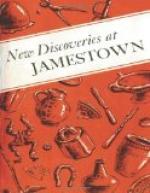Only a few parts belonging to heavy farming implements have been unearthed, including a few ploughshares and small metal fragments from wagons, carts, and harrows.
Fishing
When the first settlers planted their small colony at Jamestown, the tidewater rivers and bays and the Atlantic Ocean bordering the Virginia coast teemed with many kinds of fish and shellfish which were both edible and palatable. Varieties which the colonists soon learned to eat included sheepshead, shad, sturgeon, herring, sole, white salmon, bass, flounder, pike, bream, perch, rock, and drum, as well as oysters, crabs, and mussels. Seafood was an important source of food for the colonists, and at times, especially during the early years of the settlement, it was the main source.
Those in England who planned to go to Virginia were always advised to provide themselves (among other items) with nets, fishhooks, and lines.
During archeological explorations, fishhooks, lead net weights, fish-gigs, and small anchors were uncovered. These are reminders of a day when fish and shellfish were abundant in every tidewater Virginia creek, river, and bay.
Health
Keeping well and healthy, even managing to stay alive in the unfamiliar Virginia wilderness during the first two decades of the Jamestown settlement, was no easy matter. In the group of 105 original settlers, 67 died during the first 8 months. During the hard winter of 1609-10 (known as the “starving time"), the population dwindled from 500 to about 60 as a result of sickness, Indian attacks, and famine.
One of the members of the first colony was a surgeon, William Wilkinson by name. As the colony grew, other surgeons, physicians, and apothecaries, emigrated to Virginia. Their lot was not easy, for it appears that they were seldom idle in an island community having more than its share of “cruell diseases, Swellings, Flixes, Burning Fevers, warres and meere famine.”
During archeological explorations, drug jars, ointment pots, bleeding bowls, mortars and pestles, small bottles and vials, and parts of surgical instruments were recovered. These, undoubtedly, were used countless times at Jamestown by unknown “chirurgions,” doctors of “physickes,” and apothecaries—men who tried to keep the colonists well with their limited medical equipment and scant supply of drugs.
Amusements and Pastimes
The difficult and time-consuming job of conquering the Virginia wilderness (clearing the land, building homes, planting and harvesting crops, and warding off Indian attacks) left few hours for leisure and amusements. There were times, however (especially after the first few hard years had passed), when a colonist could enjoy himself by smoking his pipe, playing a game, practicing archery, bowling, playing a musical instrument, singing a ballad, or taking part in a lively dance. Excavated artifacts reveal that the settlers enjoyed at least these few amusements and pastimes.




